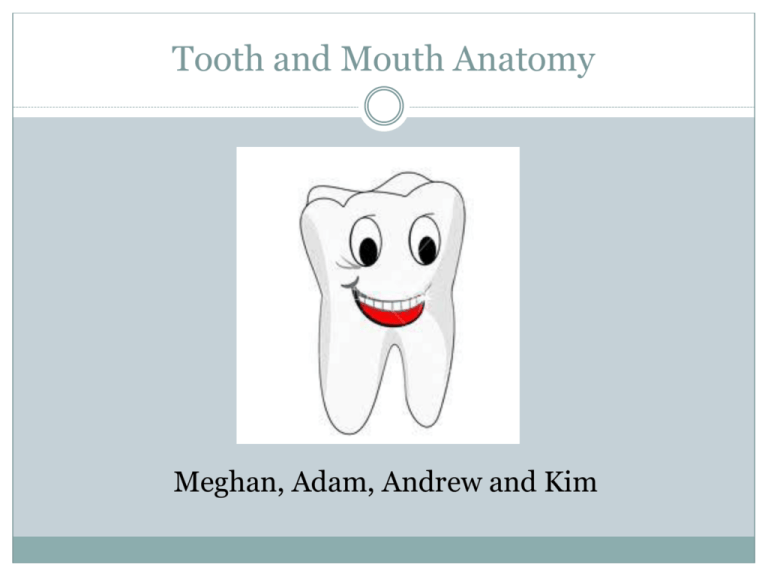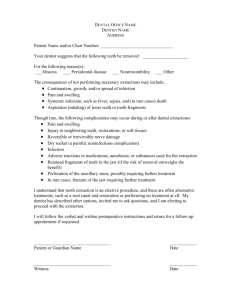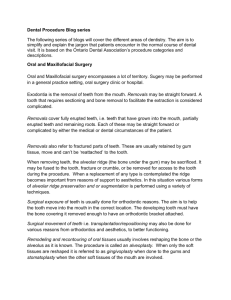Connective Tissue
advertisement

Tooth and Mouth Anatomy Meghan, Adam, Andrew and Kim Fun Video http://www.youtube.com/watch?v=NeRblbkdBVo Learning Objectives Classify different types of teeth with their structure and function Develop larger understanding of mouth structure and how teeth fit in Define common diseases and injuries related to the mouth Summarize common methods of treatment and prevention of disease and injury Dontium= “Teeth” Periodontium= “around the dontium” Temporomandibular Joint=TMJ Fossa= ditch or trench in a bony member VS. Process=a protrusion of boney member Syn= “with” or “together” Gomphis= “bolt” or “nail” Arthro = “joint” Condyle= “knuckle” Ginglymus= “hinge” Sulcus=“groove” // to Traverse Plane Spine Dental Arches Mouth Members & Interactions Overview: [The TMJ] Boney Members Skull Jaw Maxilla Mandible Connective Tissue Capsule Ligaments Stylomandibular ligament Capsular Ligament Sphenomandibular Ligament Temporomandibular Ligament Muscle Tissue Masseter Pterygoid Temporalis [The Gomphyses] Teeth Incisors Canine Premolars Molars Wisdom Teeth Periodontium Connective Tissue Periodontal Ligaments Soft Tissue Gingival Epithelial Hemidesmosomes Temporomandibular Joint (TMJ) Function Class (describes movement) Ginglymoarthrodial Ginglymus Hinge Arthrodial plane Structural Class (describes binding tissues) Synovial Bony Members Muscle Tissue Temporalis Lateral Pterygoid Masseter Medial Pterygoid Connective Tissue Stylomandibular ligament Capsular Ligament Sphenomandibular ligament Temporomandibular ligament Articular Fossa Articular cartilage Synovial Fluid Articular disk Synovial Fluid Articular Cartilage Mandibular Condyle Gomphyses Gomphosis “nail/bolt” Functional Class Synarthrosis Peg and socket between: • Tooth • Alveolus Structural Class Fibrous Teeth Structure of Teeth Crown Enamel Dentine/Ivory Root Dental Pulp Cementum Types of Teeth Incisors Types of Teeth Canines Types of Teeth Premolars Types of Teeth Molars Types of Teeth Wisdom Teeth (3rd Molar) Types of Teeth Children have 20 total teeth Primary or Milk teeth Adults have 32 total teeth Permanent or Adult teeth Adolescent Mouth Adult Mouth Tooth Connection to Jaw Alveolar bone Root Periosteum Connective Tissue Periodontal Ligaments(PDL’s) Fibrous Composition Cellular Osteoblasts Osteoclasts Fibroblasts Macrophages Cementoblasts Epithelial cell rests of Malassez Extracellular Matrix Collagen Ground Substance Water • ~70% Hemidesmosomes Small stud or rivet like structures that attach a cell to an extracellular matrix Soft Tissue Gingiva (gums) :The mucosal tissue that overlays the jaws Marginal Tissue that apically borders crown of tooth Attached Extension of the Marginal Gingiva apical to crown Interdental Tissue Between Tooth-Tooth boundaries along the dental arch Oral Epithelium Sulcular epithelium touches but is not attached to tooth non-keratinized stratified squamous tissue Junctional epithelium forms an attachment to the tooth basal lamina Extracellular matrix secreted by epithelial cells • Layer on which epithelium sits proteoglycans Teeth Pathologies and Treatment Dentistry Dentist Many specialties Orthodontics Endodontics Periodontics Diagnosis Ask health questions Clinical exam Impressions of teeth Photos of face and teeth X-rays of mouth and head Decide what treatment is right Teeth Pathologies and Treatment Less Severe Alignment Issues (malocclusion) Tooth Sensitivity Bruxism (clenching and grinding) Malocclusion of teeth Causes: Genetics Pacifier, thumb sucking Bad chewing habits Misalignment of jaw after fracture • Failure of previous dental work • • • • Treatments: • Functional appliances • Surgery Functional Appliances Fixed Braces Space maintainers Removable Retainers Splint Palatal expander Headgear Lip and cheek bumper Child vs. Adult Treatment Benefits to treating child Teeth are not permanent Growth spurts Adult Little/no jaw growth Gum disease Surgery more likely Options Lingual braces Invisalign Disadvantages Incorrect fitting Unpleasant to wear Removable Need cooperation of patient Tooth Sensitivity Causes: • • • • Enamel wear Dentin exposure Tooth/Gum disease Chipped or fractured tooth Treatments: • Desensitizing toothpaste • Sealant to cover exposed roots • Root Canal Bruxism Causes: • Stress and Anxiety • Abnormal bite Treatments: • Relax, massage and stretch jaw muscles • Ice • Avoid hard foods • Splints and mouth guards • Surgery Teeth Pathologies and Treatment More Severe Fracture Decay Infection Misalignment of Jaw Oral caner Fracture o Minor-chipping of the outer layers o Crack through tooth to center o Severe vertical, diagnol, horizontal fractures of roots Causes Impact/trauma Tooth decay Tooth infection Failure of previous dental work Treatment o Minor (outer layer) o crown o Center of tooth o Dental pulp infected o Root canal o Crown o Split root o Tooth extraction Tooth Decay Causes: • Acid and plaque build up Symptoms: • Tooth pain • Visible pits or holes in teeth Results in: • Cavities • Tooth abscess • Infection Treatment o Mild o o Fluoride Filling if cavity has formed o Severe o o o Crown Root canal Extraction http://www.youtube.com/watch?v=jHHn52KhBkQ Tooth and Gum Infection Infection of gums: Ex. Gingivitis, Periodontitis Causes: • Accumulation of bacteria or plaque • Tooth decay Symptoms: • Bad breath • Red, swollen gums • Painful chewing Treatment o Mild o Antibiotics -- medicine, gel o Cut open abscess -- drain o Severe o Root canal o Tooth extraction o Surgery o o Bone and tissue grafts Growth factors Bone and Tissue Grafts Grafting Gum Soft tissue Connective tissue Tunnel grafting Bone Autogenous Allograft Xenograft Jaw Problems o Mandibular fracture o Dislocation o Cause: Typically impact Symptoms Mandibular Bleeding and bruising Limited movement Swelling Stiffness Abnormal appearance Dislocation Crocked bite Drooling Pain Difficulty speaking Treatment o Mandibular o Minor o o o Medication Liquid diet Severe o Surgery o Dislocation o Place back o Anesthetics and muscle relaxants o Surgery Temporomandibular Joint Disorder (TMJ) Causes: • Disk erodes or moves out of proper alignment • impact • Cartilage damage due to arthritis Symptoms: • Locking of jaw • Difficulty chewing • Pain of jaw or around ear Treatment • Noninvasive: • Acupuncture • Jaw exercises • Medication • Surgery: • Arthrocentesis or joint irregation • Arthroplasty • Total Joint Replacement Dental Implants Endosseous Implant Transosteal Implant Subperiosteal Implant Implant Process • Immediate Load Implants • Implants Loaded in Phases • http://www.youtube.com/watch?v=yZY_WrR4dEI& feature=endscreen Oral Cancer Most common in: • Lips or tongues • Also found in cheek lining, gums, and floor or roof of mouth Risk Factors: • • • • • Smoking and other tobacco use Poor dental hygiene Chronic irritation Family history Sun exposure Symptoms o Sore, lump, ulcer o Difficulty chewing and swallowing o Swollen lymph nodes in neck Treatment Depends on stage Surgery Radiation therapy Chemotherapy








